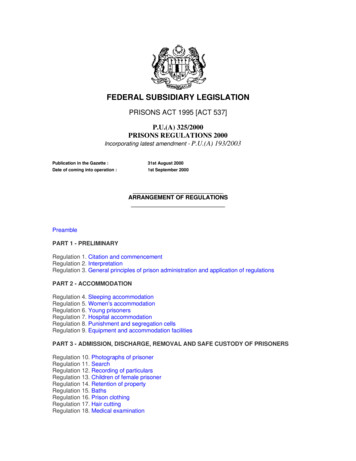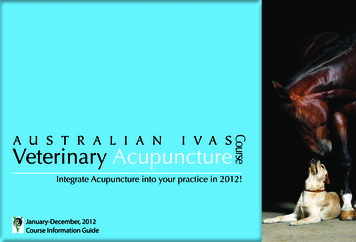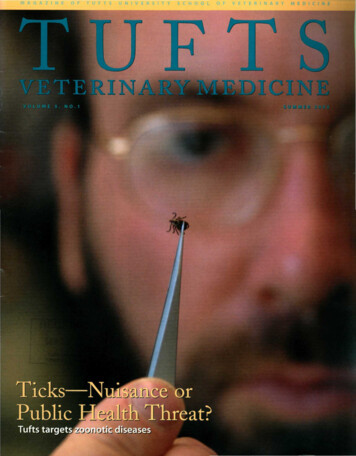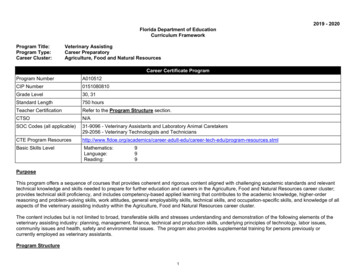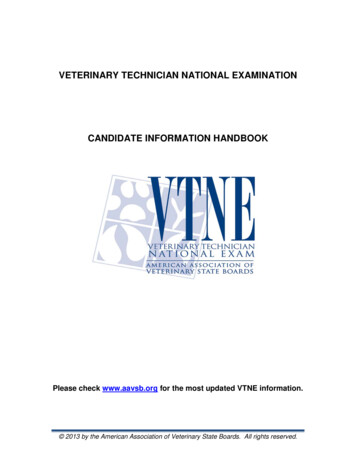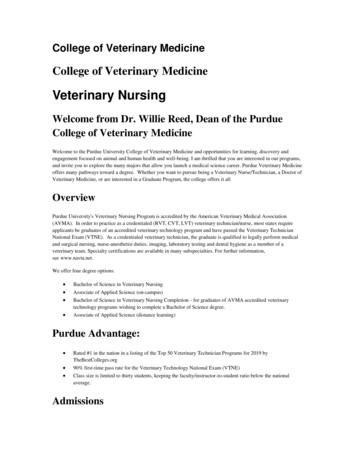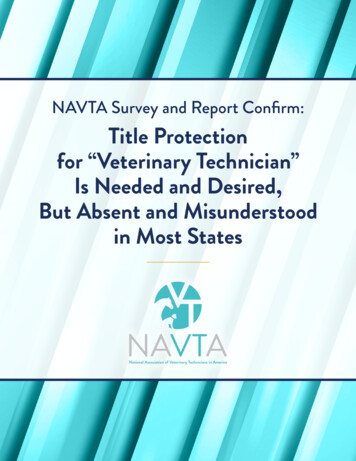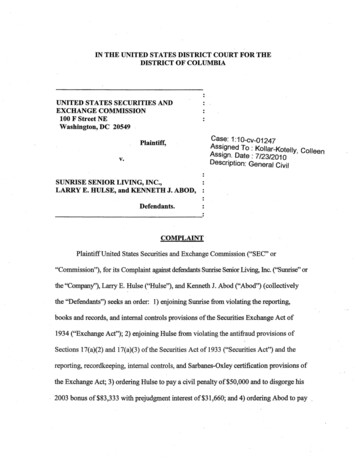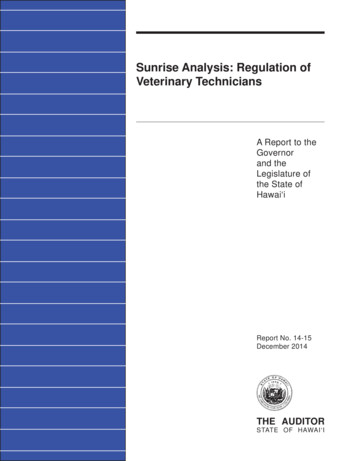
Transcription
Sunrise Analysis: Regulation ofVeterinary TechniciansA Report to theGovernorand theLegislature ofthe State ofHawai‘iReport No. 14-15December 2014THE AUDITORSTATE OF HAWAI‘I
Office of the AuditorThe missions of the Office of the Auditor are assigned by the Hawai‘i State Constitution(Article VII, Section 10). The primary mission is to conduct post audits of the transactions,accounts, programs, and performance of public agencies. A supplemental mission is toconduct such other investigations and prepare such additional reports as may be directedby the Legislature.Under its assigned missions, the office conducts the following types of examinations:1.Financial audits attest to the fairness of the financial statements of agencies. Theyexamine the adequacy of the financial records and accounting and internal controls,and they determine the legality and propriety of expenditures.2.Management audits, which are also referred to as performance audits, examine theeffectiveness of programs or the efficiency of agencies or both. These audits arealso called program audits, when they focus on whether programs are attaining theobjectives and results expected of them, and operations audits, when they examinehow well agencies are organized and managed and how efficiently they acquire andutilize resources.3.Sunset evaluations evaluate new professional and occupational licensing programs todetermine whether the programs should be terminated, continued, or modified. Theseevaluations are conducted in accordance with criteria established by statute.4.Sunrise analyses are similar to sunset evaluations, but they apply to proposed ratherthan existing regulatory programs. Before a new professional and occupationallicensing program can be enacted, the statutes require that the measure be analyzedby the Office of the Auditor as to its probable effects.5.Health insurance analyses examine bills that propose to mandate certain healthinsurance benefits. Such bills cannot be enacted unless they are referred to the Officeof the Auditor for an assessment of the social and financial impact of the proposedmeasure.6.Analyses of proposed special funds and existing trust and revolving funds determine ifproposals to establish these funds are existing funds meet legislative criteria.7.Procurement compliance audits and other procurement-related monitoring assist theLegislature in overseeing government procurement practices.8.Fiscal accountability reports analyze expenditures by the state Department ofEducation in various areas.9.Special studies respond to requests from both houses of the Legislature. The studiesusually address specific problems for which the Legislature is seeking solutions.Hawai‘i’s laws provide the Auditor with broad powers to examine all books, records,files, papers, and documents and all financial affairs of every agency. The Auditor alsohas the authority to summon persons to produce records and to question persons underoath. However, the Office of the Auditor exercises no control function, and its authority islimited to reviewing, evaluating, and reporting on its findings and recommendations to theLegislature and the Governor.THE AUDITORSTATE OF HAWAI‘IKekuanao‘a Building465 S. King Street, Room 500Honolulu, Hawai‘i 96813
Sunrise Analysis: Regulation of VeterinaryTechniciansReport No. 14-15, December 2014Regulation of veterinary technicians is not necessaryOffice of the Auditor465 S. King StreetRm. 500Honolulu, HI 96813Ph. (808) 587-0800Jan K. YamaneActing State AuditorState of Hawai‘i“[W]hen states havethe power to grantlicensure status toindividuals, theyalso have the powerto deny individualsthe opportunity toearn a living in thatprofession . . . . Thisis an impressivepower that statespossess and one thatmust be exercisedjudiciously.”— Council on Licensure,Enforcement andRegulationSenate Bill No. 2502, Senate Draft 1, of the 2014 Legislature proposes to regulate veterinary techniciansand the practice of veterinary technology under Chapter 471, Hawai‘i Revised Statutes, VeterinaryMedicine. The bill would require veterinary technicians to register with the Board of Veterinary Examiners,limit the use of certain titles related to the practice of veterinary technology, and incorporate veterinarytechnicians into existing disciplinary measures in Chapter 471, HRS.Proposed regulation does not meet “sunrise” criteriaStatutory criteria for evaluating whether a profession or vocation merits state regulation require thatproponents of regulation provide evidence supporting this need to engage the state’s police powers.We found no evidence of abuses by veterinary technicians to merit regulation. Other than anecdotalrisks of harm, we did not find any evidence to support a need to protect consumers’ health, safety,or welfare from the activities of veterinary technicians. Furthermore, these risks are satisfactorilymitigated by existing requirements that veterinary technicians work under the direct supervision of aveterinarian.Most states regulate veterinary technicians, but we found that the current proposal is motivatedprimarily by an industry effort to establish national professional standards. We also found that theproposed regulation would restrict certain qualified individuals from entering the field of veterinarytechnology, and that the effect of regulation on cost to consumers is unknown. On balance, there isno demonstrable need for the State to regulate veterinary technicians in Hawai‘i.Proposed regulatory measure is flawedSB No. 2502, SD 1 (2014), contains several flaws that would undermine a successful regulatoryprogram. Specifically, the practice definition for veterinary technology is overly broad, makingit difficult to enforce the proposed regulation. The bill’s educational qualifications for successfulregistration as a veterinary technician are too narrow and do not provide any alternative avenues forqualification. In addition, the proposed regulation does not address interstate reciprocity and fails toprovide veterinary technicians with a representative on their own regulating body. The bill also callsfor registration but essentially describes a level of regulation akin to licensure, the strictest form ofregulation.Agency responseRecommendationsResponsesFor the full text of this andother reports, visit our website:http://auditor.hawaii.gov/The Department of Commerce and Consumer Affairs concurred with our findings regarding theestimated cost of funding a veterinary technician regulatory program and its financial impact onregistrants. The department also expressed appreciation for our discussion regarding the difficultyof administering the broad scope of practice as defined in SB No. 2502, SD 1 (2014).
Sunrise Analysis: Regulation ofVeterinary TechniciansA Report to theGovernorand theLegislature ofthe State ofHawai‘iSubmitted byTHE AUDITORSTATE OF HAWAI‘IReport No. 14-15December 2014
ForewordThis analysis of the need to regulate veterinary technicians and thepractice of veterinary technology was prepared in response to HouseConcurrent Resolution No. 66 of the 2014 Legislature, which askedthe Auditor to examine the regulation of veterinary technicians and thepractice of veterinary technology proposed in Senate Bill No. 2502,Senate Draft 1, of the 2014 legislative session. The report presentsour findings and recommendations on whether regulating veterinarytechnicians and the practice of veterinary technology complies withpolicies in Hawai‘i’s “sunrise” law (Chapter 26H, Hawai‘i RevisedStatutes) and the probable effects of the proposed regulation.We wish to express our appreciation for the cooperation and assistanceextended by staff of the Department of Commerce and Consumer Affairsand other organizations and individuals whom we contacted during thecourse of our evaluation.Jan K. YamaneActing State Auditor
Table of ContentsChapter 1IntroductionBackground on Veterinary Technicians .1Objectives of the Analysis .5Scope and Methodology .5Chapter 2Regulation of Veterinary Technicians IsNot NecessarySummary of Findings .9Regulation of Veterinary Technicians IsNot Necessary .9Proposed Regulatory Measure Is Problematic . 15Conclusion . 17Recommendation . 17Response of the Affected Agency . 19ExhibitsExhibit 1.1Exhibit 2.1Regulation of Veterinary Technicians in the U.S. .3DCCA Cost Estimate of Veterinary TechnicianRegulatory Program . 14v
Chapter 1IntroductionThis report responds to House Concurrent Resolution No. 66 ofthe 2014 legislative session, which asks the Auditor to conduct a“sunrise” review of the proposal to regulate veterinary techniciansand the practice of veterinary technology in Senate Bill No. 2502,Senate Draft 1 (SB No. 2502, SD 1), of the 2014 legislative session.The bill proposes to regulate veterinary technicians and the practiceof veterinary technology under Chapter 471, Hawai‘i Revised Statutes(HRS), Veterinary Medicine. The bill would require veterinarytechnicians to register with the Board of Veterinary Examiners, limitthe use of certain titles related to the practice of veterinary technology,and incorporate veterinary technicians into existing disciplinary measuresin Chapter 471, HRS.Section 26H-6, HRS, of the Hawai‘i Regulatory Licensing ReformAct requires that bills proposing regulation of previously unregulatedprofessions or vocations be referred to the Auditor for analysis. Theseanalyses are known as sunrise reviews. The Auditor is to assess whetherregulation is necessary to protect the health, safety, and welfare ofconsumers and is consistent with other regulatory policy provisions inSection 26H-2, HRS. In addition, the Auditor must examine the probableeffects of proposed regulation and assess alternative forms of regulation.Backgroundon terinary technicians deliver veterinary care services by providingprofessional support to veterinarians. The practice of veterinarytechnology encompasses a wide range of services that require a technicalunderstanding of veterinary medicine. Working under the direction,supervision, and oversight of veterinarians, veterinary technicians areutility players on a veterinary team.In clinics, veterinary technicians act as veterinarians’ nurses, laboratorytechnicians, radiology technicians, anesthetists, pharmacy technicians,dental hygienists, surgical nurses, and client educators. Veterinarytechnicians provide support in all aspects of animal care, includingadministering anesthesia; assisting in surgery; collecting samplesand performing laboratory tests; taking and developing x-rays; andadministering medication, vaccines, and treatments prescribed by aveterinarian. While veterinary technicians provide a wide range oftechnical support, they cannot diagnose animals, perform surgery, orprescribe medication.Report No. 14-15 / December 20141
Chapter 1: IntroductionAs of 2012, the U.S. Bureau of Labor Statistics estimated there were atleast 84,800 individuals practicing in the field of veterinary technology.Veterinary technicians generally work in private clinical practicesbut are also employed in other areas such as biomedical research,the pharmaceutical industry, zoo/wildlife medicine, the military, andlivestock health management. Veterinary technicians also serve thepublic in the Hawai‘i Department of Agriculture’s Division of AnimalIndustry, helping to ensure the state remains free of rabies.National organizationsand examinationNational Association for Veterinary Technicians in AmericaThe national professional body for veterinary technicians is the NationalAssociation for Veterinary Technicians in America (NAVTA). Formedin 1981, NAVTA’s mission is to represent and promote the professionof veterinary technology. NAVTA extends membership to anyone inthe veterinary industry, including credentialed veterinary technicians,veterinary assistants, veterinarians, educators, and students. However,voting rights are extended only to veterinary technicians who havegraduated from a program accredited by the American VeterinaryMedical Association (AVMA) or who are otherwise licensed, certified, orregistered as a veterinary technician.American Veterinary Medical AssociationThe AVMA, established in 1863, is the national veterinary organizationrepresenting more than 85,000 veterinarians. In addition to advocatingfor veterinarians, the AVMA offers consultation on the education ofveterinary technicians, their use, regulation, and other related matters.The AVMA has a committee on veterinary technician education andactivities that provides and monitors the accreditation of veterinarytechnology programs across the country. All AVMA-accredited programsin veterinary technology must meet the committee’s standards to ensurethe quality of veterinary technology education and the assessment ofstudent knowledge and skills. The only AVMA-accredited veterinarytechnology program in Hawai‘i is at the University of Hawai‘i’sWindward Community College on O‘ahu.The AVMA also advocates uniformity in veterinary nomenclature,including the term “veterinary technician.” Both the AVMA and NAVTAproduced model veterinary practice acts to guide states in creating andamending their respective laws governing the veterinary field, and bothorganizations promote similar definitions of who is to be considereda veterinary technician: an individual who is a graduate of an AVMAaccredited program in veterinary technology.2Report No. 14-15 / December 2014
Chapter 1: IntroductionVeterinary Technician National ExaminationThe Veterinary Technician National Examination (VTNE) is a nationallyadministered test to evaluate entry-level veterinary technicians’competency to practice and be credentialed. In many jurisdictions thatregulate veterinary technicians, a passing score on the VTNE serves asone criterion for credentialing. The VTNE consists of 170 multiplechoice questions that cover the major areas of responsibility deemedessential for an entry-level veterinary technician. This score is acceptedand transferrable between jurisdictions that use the VTNE as a criterionfor credentialing.Regulation in otherstatesHawai‘i is one of only 13 states that do not regulate veterinarytechnicians. In 11 of these 13 states, veterinary technicians haveaccess to voluntary credentialing programs. For example, Florida doesnot regulate veterinary technicians, but veterinary technicians in thatstate can choose to obtain certification as a veterinary technician fromthe Florida Veterinary Technician Association, a private non-profitassociation.Of the 37 states that do regulate veterinary technicians, 14 requireregistration, nine require certification, and 14 require licensure.Exhibit 1.1 shows the various states’ regulatory programs.Exhibit 1.1Regulation of Veterinary Technicians in the U.S.Source: Office of the Auditor based on information from the AVMA and the American Association of Veterinary State BoardsReport No. 14-15 / December 20143
Chapter 1: IntroductionProposal to regulateveterinary techniciansin Hawai‘iSB No. 2502, SD 1, would establish requirements for regulatingveterinary technicians and the practice of veterinary technologyunder Chapter 471, HRS, Veterinary Medicine. The measurecontains provisions relating to registration requirements; educationalrequirements; limitations on the use of titles; grounds for refusal to grant,revoke, or suspend registration; hearings; and criminal penalties. Keyprovisions of the bill are: On July 1, 2018, the Board of Veterinary Examiners would beginissuing certificates of registration to qualified individuals toengage in the practice of veterinary technology as a veterinarytechnician; Definitions for direct supervision, indirect supervision, induce,practice of veterinary technology, and veterinary technicianor registered veterinary technician would be added toSection 471-1, HRS; No one will be allowed to practice veterinary technology orrefer to themselves in such a way as to imply he or she is apractitioner of veterinary technology unless that person has avalid registration as a veterinary technician obtained from theBoard of Veterinary Examiners. Exceptions to the registrationrequirement are also enumerated; No one can be registered to practice veterinary technology unlessthey are at least 18 years old, have successfully completed aveterinary technology program accredited by the AVMA, andsuccessfully passed the VTNE exam; The Board of Veterinary Examiners is given the power to refuseto grant, revoke, or suspend a veterinary technician registration;and Penalties are imposed for practicing veterinary technologywithout a valid registration.The Hawai‘i Veterinary Medical Association (HVMA) testified insupport of SB No. 2502. HVMA argued that veterinary techniciansare key team members in the veterinary profession and regulationwould improve the delivery of veterinary services. The Hawai‘i Boardof Veterinary Examiners recommended deferral of the bill until thecompletion of a sunrise analysis. The Pacific Pet Alliance, a communityorganization, supported the purpose and intent of the proposed regulatorymeasure but expressed reservations that the bill could disenfranchisepart-time employees and those individuals currently working asveterinary technicians who lack formal training from an AVMA-4Report No. 14-15 / December 2014
Chapter 1: Introductionaccredited veterinary technology program. The Humane Society ofthe United States supported the intent of the measure. The Departmentof Commerce and Consumer Affairs commented that the bill does notadequately establish qualifications or the scope of practice of a veterinarytechnician, lacks clarity regarding which veterinary technician activitieswould require supervision by a veterinarian, and fails to enumerate thetypes of conduct that would give rise to disciplinary action.Objectives of theAnalysis1. Determine whether the regulation of veterinary technicians and thepractice of veterinary technology is warranted.2. Assess the probable effects of the proposed regulation and theappropriateness of alternative forms of regulation.3. Make recommendations as appropriate.Scope andMethodologyTo determine whether the proposal to regulate veterinary technicians andthe practice of veterinary technology as proposed in SB No. 2502, SD 1,is consistent with state law, we applied the criteria for regulation set forthin Chapter 26H, HRS, the Hawai‘i Regulatory Licensing Reform Act.The Legislature established policies in Section 26H-2, HRS, to ensurethat regulation of an occupation takes place only for the right reason: toprotect consumers. Regulation is an exercise of the State’s police powerand should not be imposed lightly. Consumers rarely initiate regulation;more often, practitioners themselves request regulation for benefits thatgo beyond consumer protection. For example, members of a professionsometimes believe regulation will enhance their profession’s statusor reputation. The policies set forth in Section 26H-2 reinforce thatconsumer protection is the primary purpose of regulation by stipulating: The State should regulate professions and vocations only wherereasonably necessary to protect consumers; Regulation should protect the health, safety, and welfare ofconsumers and not the profession; Evidence of abuses should be given great weight in determiningwhether a reasonable need for regulation exists; Regulation should be avoided if it artificially increases thecosts of goods and services to the consumer, unless the cost isexceeded by potential dangers to the consumer;Report No. 14-15 / December 20145
Chapter 1: Introduction Regulation should be eliminated when it has no further benefit toconsumers; Regulation should not unreasonably restrict qualified personsfrom entering the profession; and Aggregate fees for regulation and licensure must not be less thanthe full costs of administering the program.We were also guided by the publication Questions a LegislatorShould Ask, published by the Council on Licensure, Enforcement, andRegulation (CLEAR), a national organization. According to CLEAR,the primary guiding principle for legislators should be whether anunregulated profession presents a clear and present danger to the public’shealth, safety, and welfare. If it does, regulation may be necessary; ifnot, regulation is probably unnecessary and wastes taxpayers’ money.In addition to the regulatory policies in Chapter 26H, HRS, and theguidance from CLEAR, we considered other criteria, including whetheror not: The incidence or severity of harm based on documentedevidence is sufficiently real or serious to warrant regulation; Any other alternatives provide sufficient protection to consumers(such as federal programs, other state laws, marketplaceconstraints, private action, or supervision); and Most other states regulate veterinary technicians for the samereasons.In assessing the need for regulation and the specific regulatory proposal,we placed the burden of proof on proponents to justify the need forregulation. We evaluated their arguments and data against the criteriastated above. We examined the regulatory proposal and determinedwhether proponents have made a strong enough case for regulation. Itis not enough that regulation may have some benefits. We recommendregulation only if it is demonstrably necessary to protect the public.We also scrutinized the language of the regulatory proposal,SB No. 2502, SD 1, for appropriateness. We determined whether theproposed legislation appropriately fits one of the three approaches tooccupational regulation. These approaches, from most restrictive to leastrestrictive, are:6Report No. 14-15 / December 2014
Chapter 1: IntroductionMethodology Licensing. A licensing law generally gives persons who meetcertain qualifications the legal right to deliver services—that is,to practice a profession (for example, social work). Penaltiesmay be imposed on those who practice without a license. Toinstitute and monitor minimum standards of practice, licensinglaws usually authorize a board that includes members of theprofession to establish and implement rules and standards ofpractice; Certification. A certification law usually restricts the use ofcertain titles (for example, social worker) to persons who meetcertain qualifications, but does not bar others who do not use thetitle from offering such services. This restriction is sometimescalled title protection. Government certification should not beconfused with professional certification, or credentialing, byprivate organizations. For example, social workers, who mustbe licensed by the state under Section 467E-5, HRS, may alsoreceive professional certification from the National Associationof Social Workers; and Registration. A registration law simply requires practitioners toenroll with the State so that a roster or registry is created and toenable the State to keep track of practitioners. Registration maybe mandatory or voluntary.We reviewed literature on veterinary technicians, their regulation inother states, and practices, including standards promulgated by relevantnational bodies. We inquired about enforcement actions filed by the stateOffice of Consumer Protection and complaints made to the RegulatedIndustries Complaints Office of the Department of Commerce andConsumer Affairs and the Hawai‘i Better Business Bureau.We interviewed representatives of Hawai‘i’s Board of VeterinaryExaminers, the Hawai‘i Veterinary Technician Association, the Hawai‘iVeterinary Medical Association, the Department of Commerce andConsumer Affairs, the Windward Community College veterinarytechnology program, and a non-profit organization with a vested interestin the issue of regulating veterinary technicians. We attempted toidentify the costs and possible impacts of the proposed regulation.Our work was performed from May 2014 to October 2014 in accordancewith the Office of the Auditor’s Manual of Guides.Report No. 14-15 / December 20147
Chapter 1: IntroductionThis page is intentionally left blank.8Report No. 14-15 / December 2014
Chapter 2Regulation of Veterinary Technicians Is NotNecessaryThis chapter presents our findings and recommendations on theproposal to regulate veterinary technicians and the practice of veterinarytechnology as proposed in Senate Bill No. 2502, Senate Draft 1(SB No. 2502, SD 1), of the 2014 legislative session. The Hawai‘iRegulatory Licensing Reform Act, Chapter 26H, Hawai‘i RevisedStatutes (HRS), limits the regulation of certain professions and vocationsto situations in which it is reasonably necessary to protect the health,safety, and welfare of consumers. We found that although regulatingveterinary technicians would provide some benefits, it is unnecessary toprotect the public. We conclude that SB No. 2502, SD 1, should not beenacted.Summary ofFindings1. Regulation of veterinary technicians is not necessary becauseproponents failed to provide sufficient evidence indicating regulationis demonstrably necessary to protect consumers. Additionally,current alternatives to regulation exist and provide sufficientconsumer protection.2. The proposed regulatory measure is problematic.Regulationof VeterinaryTechnicians Is NotNecessaryThe proposed regulatory measure, SB No. 2502, SD 1, does not meetcriteria for the regulation of professions or vocations in Chapter 26H,HRS. We found no evidence of abuses by veterinary technicians tomerit regulation. Other than anecdotal risks of harm, we did not findany evidence to support a need to protect consumers’ health, safety, orwelfare from the activities of veterinary technicians. Furthermore, theserisks are satisfactorily mitigated by existing requirements that veterinarytechnicians work under the direct supervision of a veterinarian. Wefound that most states regulate veterinary technicians but that the currentproposal is motivated primarily by an industry effort to establish nationalprofessional standards. We also found that the proposed regulationwould restrict certain qualified individuals from entering the fieldof veterinary technology, and that the effect of regulation on cost toconsumers is unknown. On balance, there is no demonstrable need forthe State to regulate veterinary technicians in Hawai‘i.Report No. 14-15 / December 20149
Chapter 2: Regulation of Veterinary Technicians Is Not NecessaryAbsence of abusesweighs heavily againstregulationStatutory criteria for evaluating whether a profession or vocation meritsstate regulation require that proponents of regulation provide evidencesupporting this need to engage the state’s police powers. Evidencemust show that serious harm can result to consumers if the professionor vocation remains unregulated. Although veterinary technicians areintegral to delivering veterinary care, we found no evidence that throughtheir activities they pose a clear and present danger to consumers—apoint that weighs heavily against the need for regulation. We foundthat although most other states regulate veterinary technicians, thesupervisory oversight provided by veterinarians is a sufficient alternativeto regulation. We also found the impetus for the regulatory proposal isthe result of national professional trends and industry interests.No evidence of threat to consumers’ health, safety, or welfareFor a profession or vocation to be regulated, evidence is needed todemonstrate a risk to consumers’ health, safety, or welfare from theactivity to be regulated. We sought evidence of abuse or threat of harmposed to consumers of veterinary services and the general public. Whilewe found that health risks exist, in the form of diseases that can betransferred from animals to humans, we found no data showing that theunregulated activities of veterinary technicians pose a threat to publichealth or consumers’ (that is, pet owners’) welfare.We researched complaints about veterinary technicians made to theDepartment of Commerce and Consumer Affairs’ (DCCA) Office ofConsumer Protection and Regulated Industries Complaints Office, thestate Ombudsman, and the Hawai‘i Better Business Bureau (BBB) in thelast three years. The BBB reported it has 20 complaints related to theveterinary industry since 2011; however, none of these were specificallyattributed to veterinary technicians. The other agencies reported theyhave received no complaints regarding veterinary technicians.We also asked representatives of the Hawai‘i Veterinary MedicalAssociation (HVMA), Hawai‘i Veterinary Technician Association(HVTA), and the state Board of Veterinary Examiners (BVE) whetherthey knew of any evidence of abuse or threat to public or consumerhealth, safety, or welfare posed by veterinary technicians. Althoughone proponent pointed out that veterinary technicians play a role inpreventing and controlling the spread of zoonotic (of animal origin)diseases1 from animals to humans, none of these stakeholders was ableto provide any evidence showing that the presence, absence, or ability ofveterinary technicians has adversely impacted public health.110Examples of zoonotic diseases are anthrax, dengue, Ebola hemorrhagic fever, E. coli and salmonellosis infection, Lyme disease,malaria, bubonic plague, and West Nile viral infection.Report No. 14-15 / December 2014
Chapter 2: Regulation of Veterinary Technicians Is Not NecessaryBoth the veterinarians and veterinary technicians we interviewed stressedthe strong emotional connection between owners and their pets, arguingthat regulation would provide assurance to consumers that their animalsare receiving care from qualified provid
veterinary technicians, their use, regulation, and other related matters. The AVMA has a committee on veterinary technician education and activities that provides and monitors the accreditation of veterinary technology programs across the country. All AVMA-accredited programs in veterinary technology must meet the committee's standards to ensure

